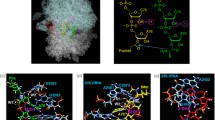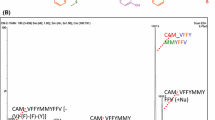Abstract
The objective of the present work was to determine whether it is possible to use a nonhydrolyzable analog of ATP (AMP-PNP) as an inhibitor of ATP-dependent scanning of the leader sequence of eukaryotic mRNA in translation initiation. The formation of ribosomal 48S initiation complexes at the start codon of the capped mRNA leader sequence of rabbit β-globin mRNA was studied. The study was carried out in a system composed of individual components of translation initiation. The dependences of the efficiency of formation of 48S initiation complexes on ATP concentration and incubation time were obtained in the absence and presence of AMP-PNP. It was found that AMP-PNP did not affect the efficiency of formation of 48S initiation complexes in all cases under study. We conclude that the uncleavable analog of ATP, AMP-PNP, is not an inhibitor of translation initiation in eukaryotes.
Similar content being viewed by others
Abbreviations
- AMP-PNP:
-
5′-adenylyl-imidodiphosphate
- CXR:
-
carboxy-X-rhodamine
References
Kozak M. (1978) How do eucaryotic ribosomes select initiation regions in messenger RNA? Cell, 15, 1109–1123.
Vassilenko, K. S., Alekhina, O. M., Dmitriev, S. E., Shatsky, I. N., and Spirin, A. S. (2011) Unidirectional constant rate motion of the ribosomal scanning particle during eukaryotic translation initiation, Nucleic Acids Res., 39, 5555–5567.
Spirin A. S. (2009) How does a scanning ribosomal particle move along the 5′-untranslated region of eukaryotic mRNA? Brownian Ratchet model, Biochemistry, 48, 10688–10692.
Rogers, G. W., Jr., Komar, A. A., and Merrick, W. C. (2002) eIF4A: the godfather of the DEAD box helicases, Nucleic Acid Res. Mol. Biol., 72, 307–331.
Bi X., Ren J., and Goss D. J. (2000) Wheat germ translation initiation factor eIF4B affects eIF4A and eIFiso4F helicase activity by increasing the ATP binding affinity of eIF4A, Biochemistry, 39, 5758–5765.
Hartz, D., McPheeters, D. S., Traut, R., and Gold, L. (1988) Extension inhibition analysis of translation initiation complexes, Methods Enzymol., 164, 419–425.
Shirokikh, N. E., and Spirin, A. S. (2008) Poly(A) leader of eukaryotic mRNA bypasses the dependence of translation on initiation factors, Proc. Natl. Acad. Sci. USA, 2105, 10738–10743.
Abramson, R. D., Dever, T. E., Lawson, T. G., Ray, B. K., Thach, R. E., and Merrick, W. C. (1987) The ATP-dependent interaction of eukaryotic initiation factors with mRNA, J. Biol. Chem., 262, 3826–3832.
Harms, U., Andreou, Z. A., Gubaev, A., and Klostermeier, D. (2014) eIF4B, eIF4G and RNA regulate eIF4A activity in translation initiation by modulating the eIF4A conformational cycle, Nucleic Acids Res., 42, 7911–7922.
Kopeina, G. S., Afonina, Z. A., Gromova, K. V., Shirokov, V. A., Vasiliev, V. D., and Spirin, A. S. (2008) Step-wise formation of eukaryotic double-row polyribosomes and circular translation of polysomal mRNA, Nucleic Acids Res., 36, 2476–2478.
Author information
Authors and Affiliations
Corresponding author
Additional information
Original Russian Text © P. A. Sakharov, A. S. Sokolov, S. Ch. Agalarov, 2015, published in Biokhimiya, 2015, Vol. 80, No. 1, pp. 59–64.
Originally published in Biochemistry (Moscow) On-Line Papers in Press, as Manuscript BM14-167, December 28, 2014.
Rights and permissions
About this article
Cite this article
Sakharov, P.A., Sokolov, A.S. & Agalarov, S.C. Nonhydrolyzable ATP analog 5′-adenylyl-imidodiphosphate (AMP-PNP) does not inhibit ATP-dependent scanning of leader sequence of mRNA. Biochemistry Moscow 80, 45–49 (2015). https://doi.org/10.1134/S0006297915010058
Received:
Revised:
Published:
Issue Date:
DOI: https://doi.org/10.1134/S0006297915010058




